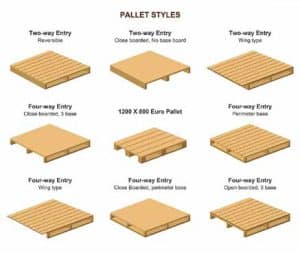Unspecified Pallets can Affect Productivity and Damage Product in Pallet Flow Systems
The characteristics of wooden pallets can vary significantly in regard to dimensions, pallet rack design, capacity, and quality, and these factors determine how goods can be stored in traditional pallet racking systems. The factors are even more critical, however, in certain types of movable racking solutions, such as pallet flow, which are designed to accommodate a specific pallet type.
 When alternate types of pallets, or defective pallets are used, incidents can occur that force suspension of normal operations, and the racking and stored goods can be damaged. Those damages and lost production time can impose unnecessary costs on the facility.
When alternate types of pallets, or defective pallets are used, incidents can occur that force suspension of normal operations, and the racking and stored goods can be damaged. Those damages and lost production time can impose unnecessary costs on the facility.
In a pallet flow system, pallets are loaded on one side of the racking and rest on sloped rails. As pallets are unloaded from the other side, the recently loaded pallets move toward the unloading side, via the force of gravity. But if a load on a pallet does not conform to the pallet rack design, if the load exceeds the pallet’s capacity, or if the pallet itself is defective, the pallet can get stuck or break apart on the rails.
“We can control about 95 percent of what happens on pallet flow racking,” says Ryan Wachsmuth, Dynamic Storage Sales Manager for Steel King Industries, a leading manufacturer of pallet racking and other material handling solutions. “But we can’t control your forklift drivers or the type of pallets you’re going to use on the system.”
A pallet flow system will be designed to handle pallets of a certain dimension and certain weight capacity. That information is a crucial part of the pallet rack design.
“When we quote a pallet flow system, we require the user to send us pallets that they will actually use on the system, so we can test those pallets to ensure the desired system can accommodate them,” Wachsmuth notes. Ideally, the end user would not only send a pallet for testing but also the load that will rest on the pallet. If that’s not feasible, a manufacturer like Steel King can mimic the load identified by the user.
What’s a “Standard” Pallet?
When Steel King asks for a pallet to test, the end user might reply that a “standard pallet” will be used. The trouble with that is that the definition of a “standard pallet” varies. The customer might say it’s a 40×42-inch pallet, but if “standard” is based on the initial pallet – the GMA 5-bottom board, that’s 40×48 inches, Wachsmuth notes, adding that “so in that scenario, there is a discrepancy in what they think is standard and what we say is standard.”
Along with the GMA standard, there are different grades of pallets: A, B, C, and D, with A being the best, brand new pallet, to D, which could be a refurbished pallet not necessarily maintained to the specifications of an A. One of the differences in specifications could be in thickness.
“A GMA standard is a half-inch-thick bottom board, but on a D, it could be a quarter-inch or three-eighths-inch bottom,” he notes, adding that having bottom boards of different thicknesses leads to a situation similar to a motorist driving on the rumble strip aside a road. “It creates vibration and shaking, which in the case of a pallet flow system, isn’t the way it should be.”
Initially, Wachsmuth notes, the standard was a GMA wood pallet with five bottom boards, with the front and rear 5.5 inches and the center boards 3.5. Through the years, pallet manufacturers have developed different pallets for various industries. Now it’s the norm to have different dimensions and capacities because loads and uses differ. That means pallet racking, including pallet flow racking, needs to be designed for the pallets.
For A Pallet Flow System, Load Positioning Is a Factor
Another factor in the pallet rack design is how the load fits on the pallet.
“We need to consider whether the load is acute on the pallet, if there is an overhang, or if there is an offset,” Wachsmuth says. “Let’s say you have a 48×40 pallet, but your load is 36×36. The weight is now concentrated on a smaller area, and that load is now carried out to the pallet flow rack wheels differently.” A more concentrated load might put more pressure on the center rail where the system’s brakes are located, and that could over-stress the brakes. So, understanding how your loads are going to rest on the pallet is another critical piece of information that we need.
The pallet flow system also can be stressed by storing pallets that exceed the design specifications.
“Let’s say the pallet flow system is designed to handle pallets that weigh up to 1,500 pounds, with four sets of wheels to allow the pallets to flow,” Wachsmuth observes. “If the end user puts 2,500-pound loads on those four sets of wheels, there would be an insufficient amount of surface-to-bottom contact for that weight. We would need to add six sets of wheels for the load to be properly distributed.”
Users also should be aware of what is meant by “capacity.”
“A pallet’s capacity might be listed at 6,000 pounds, but that’s when it’s resting on the ground with all points of the bottom board touching the floor at once,” says Wachsmuth. “When you put that pallet onto racking, you are dealing with dynamic capacity that could be, for example, 3,500 pounds. So, it’s important to know a pallet’s dynamic racking capacity.”
Removing a Broken or Stuck Pallet From A Pallet Flow System
So, what happens when a pallet breaks or gets stuck on a pallet flow rail? Each manufacturer has guidance on how to troubleshoot stuck pallets. Combine that approach with the advice of your on-site safety manager to address the situation. Steel King would typically advise the use of a tie-down strap to secure the pallet load so it won’t move. An adjacent, empty lane could then be lined with empty pallets to provide a surface for walking and to hold product that is removed from the broken or stuck pallet. As noted above, the response takes time and often requires staff from other areas, so productivity declines. And then there is the question of potentially damaged products and equipment.
“So, it emphasizes the importance of pallet quality and the use of a pallet the system was designed for,” Wachsmuth says.
Contact us today to learn more about how an efficient pallet rack design and proper use of materials can help improve your warehouse efficiencies, increase safety, and save you money on your material storage.


